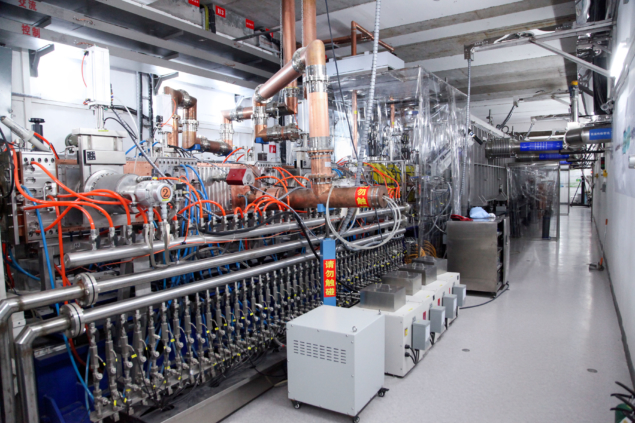
Physicists at the Institute of Modern Physics (IMP) in Lanzhou, China, have achieved a significant milestone towards an accelerator-driven sub-critical system – a proposed technology for sustainable fission energy. In February, the institute’s prototype front-end linac for the China Accelerator Driven Subcritical System (C-ADS) reached its design goal with the successful commissioning of a 10 mA, 205 kW continuous-wave (CW) proton beam at an energy of 20 MeV. The result breaks the world record for a high-power CW superconducting linac, says Yuan He, director of IMP’s Linac Center: “This result consists of ten years of hard work by IMP scientists, and brings the realisation of an actual ADS facility one step closer to the world.”
The ADS concept, which was proposed by Carlo Rubbia at CERN in late 1990s, offers a potential technology for nuclear-waste transmutation and the development of safe, sustainable nuclear power. The idea is to sustain fission reactions in a subcritical reactor core with neutrons generated by directing a high-energy proton or electron beam, which can be switched on or off at will, at a heavy-metal spallation target. Such a system could run on non-fissile thorium fuel, which is more abundant than uranium and produces less waste. The challenge is to design an accelerator with the required beam power and long-term reliability, for which a superconducting proton linac is a promising candidate.
CAFe is the world’s first CW superconducting proton linac stepping into the hundred-kilowatt level
Yuan He
In 2011, a team at IMP launched a programme to build a superconducting proton linac (CAFe) with an unprecedented 10 mA beam current. It was upgraded in 2018 by replacing the radio-frequency quadrupole and a cryomodule, but the team faced difficulties in reaching the design goals. Challenges including beam-loss control and detection, heavy beam loading and rapid fault recovery were finally overcome in early 2021, enabling the 38 m-long facility to achieve its design performance at the start of the Chinese new year. CAFe’s beam availability during long-term, high-power operation was measured to be 93- 96%, indicating high reliability: 12 hours of operation at 174 kW/10 mA and 108 hours at 126 kW/7.3 mA.
The full C-ADS project is expected to be completed this decade. A similar project called MYRHHA is under way at SCK CEN in Belgium, the front-end linac for which recently entered construction. Other ADS projects are under study in Japan, India and other countries.
“CAFe is the world’s first CW superconducting proton linac stepping into the hundred-kilowatt level,” says He. “The successful operation of the 10 mA beam meets the beam-intensity requirement for an experimental ADS demo facility – a breakthrough for ADS linac development and an outstanding achievement in the accelerator field.”





